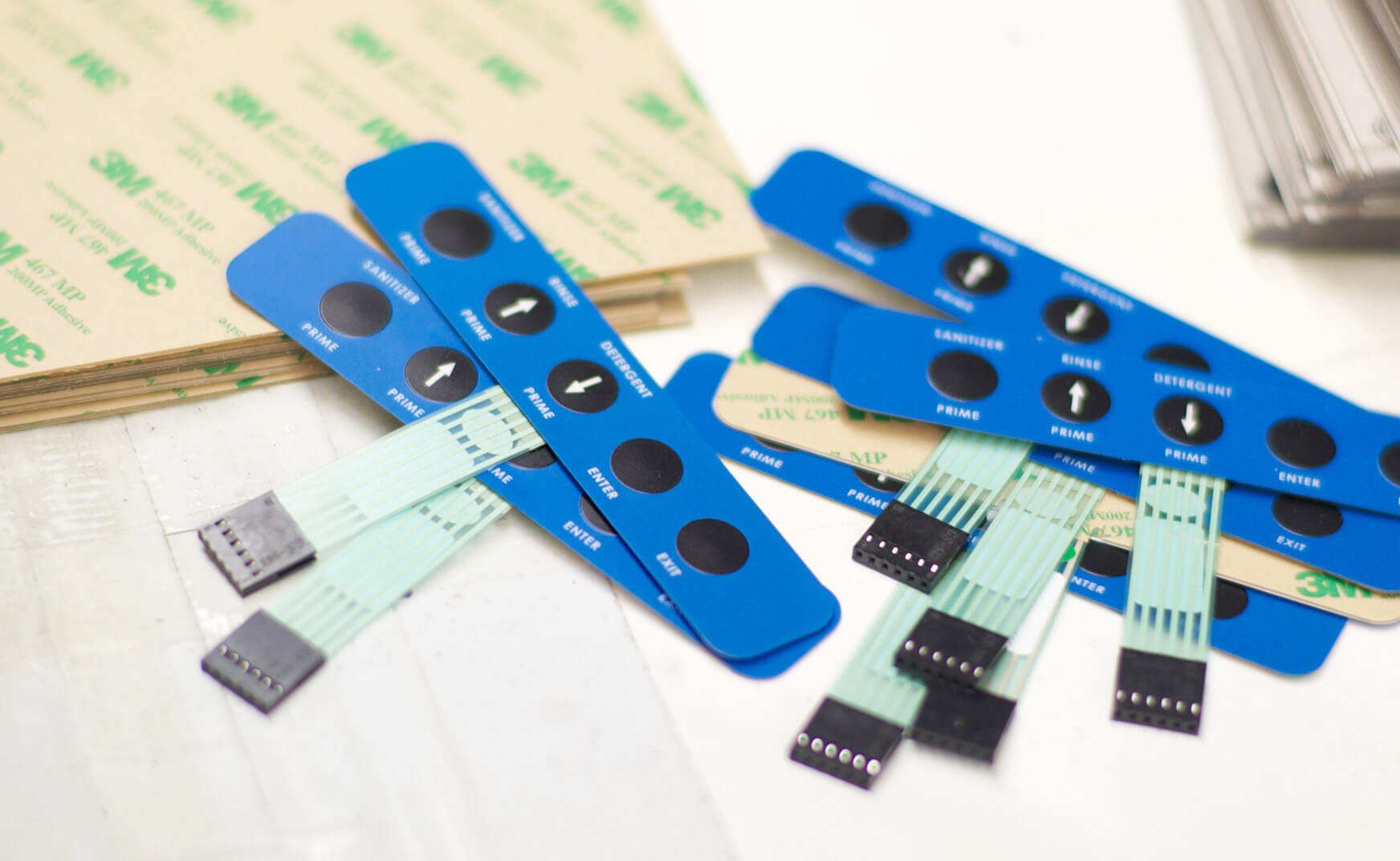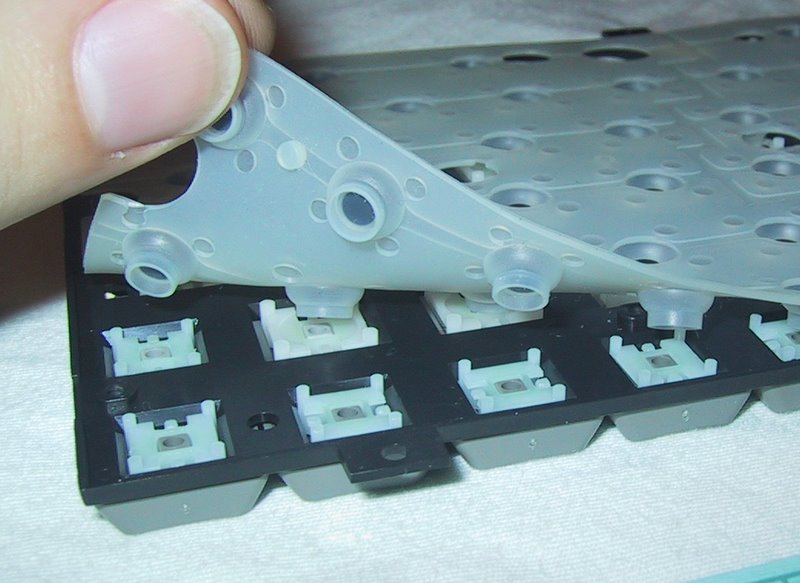Everything About Membrane Layer Change: Understanding Its Design and Performance
When you believe concerning the control interfaces in contemporary tools, membrane switches usually come to mind. Allow's explore what collections membrane switches apart from other control systems.
What Are Membrane Switches?

Membrane layer switches can likewise be customized pertaining to form, size, and graphics, permitting suppliers to create distinct user interfaces customized to certain products. In general, membrane buttons play a significant function in boosting individual experience throughout a vast range of applications.
Just How Membrane Changes Work
When you press a secret on a membrane layer button, it activates an uncomplicated yet effective device. membrane switch manufacturer. The top layer, usually made of adaptable product, presses down onto a conductive layer under it.
You'll see that the tactile responses varies based on the switch layout, offering either a soft click or a much more pronounced feedback. As soon as you release the key, the membrane returns to its original position, resuming the circuit and stopping the signal. This procedure occurs nearly instantly, making sure a receptive customer experience.
Membrane switches are preferred due to their resilience and resistance to dirt and moisture, making them suitable for different applications, from household home appliances to clinical devices. Understanding this operation assists you value their prevalent usage.
Secret Components of Membrane Buttons
Understanding the crucial components of membrane switches is fundamental for understanding their capability and design. At the core, you'll find the graphic overlay, which gives the aesthetic user interface for users. Below that, there's a spacer layer that separates the circuit layers, making sure that they do not make contact till pressed. The circuit layer is where the magic occurs; it includes conductive traces that complete the circuit when you press the button. One more vital aspect is the glue support, allowing the switch to stick to surface areas firmly. The safety layer shields versus environmental factors and wear, prolonging the switch's life expectancy. Each element plays a considerable duty in ensuring reliable performance and customer communication. By comprehending these components, you'll acquire insight into just how membrane layer changes operate and their relevance in numerous applications.
Products Used in Membrane Layer Switch Design
The performance and resilience of membrane layer switches heavily depend upon the materials utilized in their design. You normally experience polyester and polycarbonate as key substratums because of their superb stamina and versatility. These products withstand scrapes and chemicals, making them suitable for demanding settings.
The conductive layers commonly utilize silver or carbon, chosen for their reliability and conductivity. membrane switch manufacturer. Silver gives exceptional efficiency, while carbon is a cost-efficient option. For the overlay, you may consider a matte or shiny surface, depending on your aesthetic demands and customer experience
Adhesives play an essential role as well; they bond layers securely and ensure long life. Make sure to pick adhesives that hold up against environmental aspects like temperature level and humidity. Do not overlook the value of a good printing strategy for graphics, as it enhances both functionality and visual charm. Choosing the best materials will certainly guarantee your membrane layer switch stands the test of time.
Design Considerations for Membrane Switches
While making membrane buttons, it's important to take into consideration numerous factors that affect their performance and customer experience. Begin by concentrating on the layout and button dimension; make sure they're intuitive and very easy to navigate. Consider the responsive responses you wish to offer-- will customers need a visible click or a softer touch? Furthermore, think of the products you'll use, as they'll influence longevity and looks.
Validate your style suits environmental factors, like moisture or temperature level variants, which could influence performance. By very carefully taking into consideration these components, you'll produce a membrane layer switch that improves usability and contentment.
Applications of Membrane Buttons
Membrane layer switches are functional components discovered in various applications, from commercial tools to customer electronic devices. You'll see their impact in equipments that call for sturdy interfaces and in tools that profit from streamlined styles. Comprehending these applications assists you appreciate the this contact form performance and practicality of membrane buttons in day-to-day modern technology.
Industrial Devices Use
When you're looking to boost the capability of industrial equipment, membrane layer buttons supply a trusted remedy that combines sturdiness with straightforward layout. These switches are ideal for extreme atmospheres, giving resistance to dust, wetness, and chemicals. Accept membrane switches to streamline your procedures and boost general performance.
Consumer Electronic Devices Combination
In the domain of customer electronics, membrane layer buttons play an important duty in enhancing individual communication and tool capability. You'll discover them in devices like microwaves, remote controls, and video gaming consoles, giving a smooth means to connect with modern technology. Their streamlined design enables for very easy combination into different items, making controls instinctive and straightforward. With their capability to include graphics and backlighting, you can appreciate a modern-day visual that enhances the device's overall appearance. Membrane switches also guarantee resilience and resistance to dust and moisture, prolonging the lifespan of your electronic devices. By selecting membrane layer buttons, you improve not simply the capability yet also the design of your tools, making everyday interactions smooth and pleasurable.
Advantages and Downsides of Membrane Layer Buttons
While membrane layer switches provide an array of advantages, they likewise come with some drawbacks that you ought to take into consideration. One considerable benefit is their portable design, making them ideal for space-constrained applications.

Nonetheless, there are negative aspects. Membrane switches can have a much shorter life-span compared to mechanical switches, especially under heavy usage. They can likewise be less tactile, which may affect customer feedback during operation. If damaged, repairing them can be tough and commonly needs total replacement. Ultimately, their level of sensitivity to extreme temperatures and index ecological problems might limit their efficiency in certain setups. Stabilizing these advantages and disadvantages will assist you figure out if membrane switches are the right suitable for your task.
Regularly Asked Inquiries
For How Long Do Membrane Switches Usually Last?
Membrane layer switches over typically last in between 5 to one decade, depending on use and environmental problems. You'll intend to evaluate elements like wear, direct exposure to dampness, and temperature variations to determine their longevity successfully.
Can Membrane Layer Changes Be Custom-made for Particular Designs?
Yes, you can customize membrane buttons to fit particular styles (membrane switch manufacturer). You'll have the flexibility to pick colors, forms, and layouts that match your project's requirements, ensuring they blend effortlessly with your overall aesthetic
What Is the Expense Array for Membrane Change Production?
The price range for membrane switch manufacturing normally falls between $1 and $10 each, depending upon variables like layout complexity, amount, and products. You can get quotes from makers to discover the very best choice.

Are Membrane Layer Switches Over Water-proof or Resistant?
Membrane buttons can be designed more helpful hints to be water resistant or resistant, relying on materials utilized and building methods. If you require them for damp settings, guarantee you define those demands throughout the layout procedure.
How Do Membrane Switches Contrast to Conventional Switches?
Membrane switches are normally thinner and extra versatile than conventional switches, providing a sleek style. They're commonly less complicated to clean up and integrate, however may not offer the responsive feedback you're utilized to with mechanical options.
Conclusion
